Kabayan Filipino Restaurant
304 Orchard Road
#03-25 Lucky Plaza
https://www.facebook.com/KabayanFilipinoRestaurant.SG
http://www.kabayansg.com/
304 Orchard Road
#03-25 Lucky Plaza
https://www.facebook.com/KabayanFilipinoRestaurant.SG
http://www.kabayansg.com/
Authentic, Home Cooked Filipino Comfort Food
(Ratings: On a scale of 1 to 10, with 1 = Worst and 10 = Best)
Overall: 8
Ambience & Setting: 6
Food & Beverage: 8
Service: 8
Value for Money: 9
Spent about SGD $7 per person.
.....
Established in 1994, Kabayan Filipino Restaurant is among the stalwarts of Filipino cuisine in Singapore, having held its own since the beginning. Operating as part of the Kabayan group, which includes Kabayan Travel and Kabayan Remittance, Kabayan Filipino Restaurant is among the best places for Filipino food in Singapore, and the go to place for those yearning for authentic, tasty recipes from home in the Philippines.
Ambience at Kabayan Filipino Restaurant is similar to a casual cafeteria / food court, but cleaner and more well ventilated. The interior is spacious, but tables are packed quite closely together to maximise seating. I like that furniture is comfortable and sturdy, and the smell of food doesn't linger in the air. The main drawback for me is the dim, low lighting, which makes the place look darker than it should.
Service at Kabayan Filipino Restaurant is self-service, cafeteria style. Diners queue up, order from a menu or the large display case, make payment, collect the order, then collect utensils. Still, the staff at Kabayan Filipino Restaurant are very friendly, and most can understand simple English, so ordering isn't a problem. I like that staff are efficient and quick at clearing tables. Kabayan Filipino Restaurant also boasts a small in-house bakery which produces authentic Filipino desserts from various regions in the Philippines.
Prices at Kabayan Filipino Restaurant are very affordable, considering its location in Orchard Road, Lucky Plaza mall. A typical budget meal of rice with 2 dishes costs SGD $4.50 + per person, while a short-order meal from the menu costs about SGD $6.50 + per person. Desserts average about SGD $4 each. Portions sizes for meals are sufficient for 1 person, though desserts portions are large enough to be shared by 2 people.
Food at Kabayan Filipino Restaurant is prepared according to authentic Filipino recipes, by chefs who have worked in various restaurants in the Philippines. The result is rustic, home cooked style Filipino comfort food that is tasty and delicious, with each mouthful packing delightful flavour. The variety of food options at Kabayan Filipino Restaurant is extensive, drawing inspiration from various street food, and regional food around the Philippines.
The thing about cuisine from the Philippines, is the unashamedly intense taste (sweet, sour, salty) and texture (oily, crispy, tender) of each dish. Known for their bold tasting dishes, Filipino food is neither subtle or balanced, thus, may not appeal to everyone. The best way to consume Filipino food is by pairing dishes, such as sweet and salty, or by pairing with plain white rice.
.....
The place doesn't look like much, but fits with the theme of rustic home cooking, casual and comfortable. The majority of diners here are from the Philippines, which lend credibility to their dishes. They also provide catering for events.
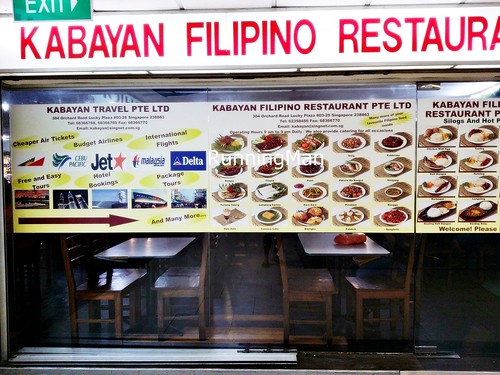 |
| Kabayan Filipino Restaurant Signage |
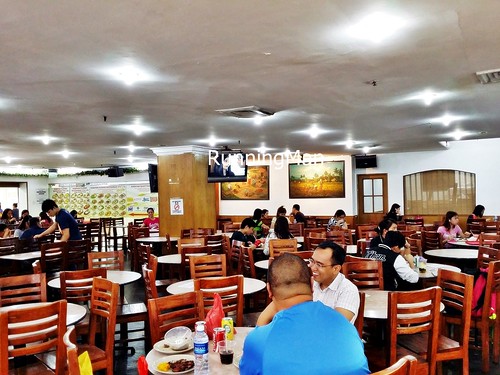 |
| Kabayan Filipino Restaurant Seating |
Tapsilog (SGD $6.50) is the Philippines portmanteau of Tapa, Sinangag, and Itlog (Fried Sunny Side Up Egg), served with a side of Atchara (Pickled Payapa Salad), and fresh cucumbers and tomato slices. A one-dish meal usually consumed for breakfast in the Philippines, here it's served only for lunch and dinner, with the portion size being rather large. The salad, with its sour tangy taste, makes a nice foil to cut through the savoury taste of the meat.
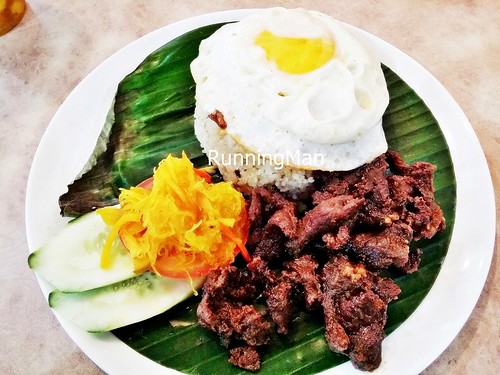 |
| Tapsilog 01 |
 |
| Tapsilog 02 |
Tapa refers to Filipino dried meat cured with salt. Beef Tapa (SGD $3) is the most common version of Tapa, typically served fried or grilled. The Beef Tapa here is tasty and flavourful, I daresay among the most intense meaty taste I've ever had, even while I was in Manila! Not overly dry, salty, or stringy, the beef tears apart easily. Very good!
 |
| Tapa Beef |
The deceptively plain-looking but fragrant Sinangag (SGD $3), or Garlic Fried Rice, has a strong but pleasant aroma that hits you when served. The rice grains are nicely fried with an even coating of the garlic flavour, albeit slightly oily. Rather sinful, but so addictive you can't stop eating it!
 |
| Sinangag Garlic Fried Rice |
Considered the national dessert of the Philippines, Halo-Halo (SGD $3.90), or 'Mix-Mix', consists of a mixture of shaved ice and coloured sugar syrup, topped with a variety of ingredients. Here, the garnishes include kidney beans, plantains, sweet potato, attap seeds, gulaman seaweed jelly, purple yam / taro ice cream, and coconut milk. The name of this iconic and much loved dessert is pronounced 'Hello-Hello', and it's similar in style to the Chendol dessert of Singapore and Malaysia.
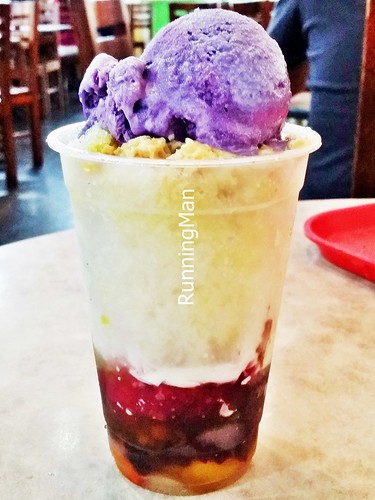 |
| Halo-Halo 01 |
 |
| Halo-Halo 02 |
The Budget Plate, also called the Turo Turo Plate (SGD $4.50), consists of plain white rice, with 2 dishes of your choice. 'Turo Turo', which means 'Point Point', is similar in concept to an economical rice stall, where you point to indicate which dish you want. Choose from about 20 or so traditional, classic Filipino dishes, with premium items costing slightly more. For an affordably low price of SGD $4.50 per plate, the portion size is sufficient for one, and it's the default option for many diners here!
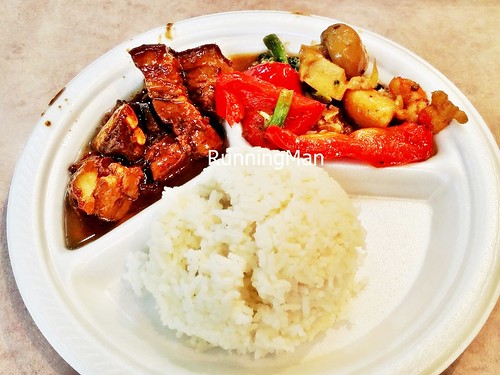 |
| Turo Turo Plate 01 |
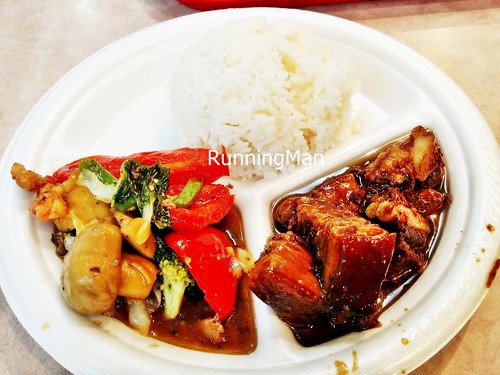 |
| Turo Turo Plate 02 |
Adobo Pork (SGD $2) is made by slow braising / stewing pork belly in a sauce of pepper, garlic, vinegar, soy sauce and bay leaves. The result is tender, soft, and fragrant meat, that is both salty and savoury. This national dish of the Philippines is best eaten with plain white rice. The version here is very oily though, I typically allow the oil to drip off first before eating it.
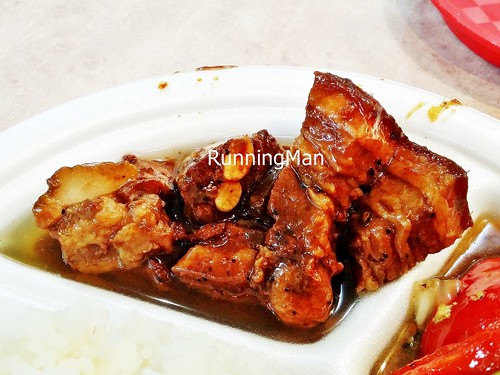 |
| Adobo Pork |
A popular and common Filipino Chinese fusion dish, Chop Suey Guisado (SGD $2) consists of a medley of vegetables, stir fried together with either meat or seafood. The version here includes spinach, button mushroom, onions, bell peppers / capsicum, cauliflower, broccoli, and cabbage, stir fried in oyster sauce, with prawns, fish cake, and a small amount of pork liver. The vegetables are fresh, tasty, and clean, plus the overall dish isn't too oily. But it's slightly let down by the use of frozen prawns. The use of pork liver though, surprised me, as it lent an earthy taste to the vegetables.
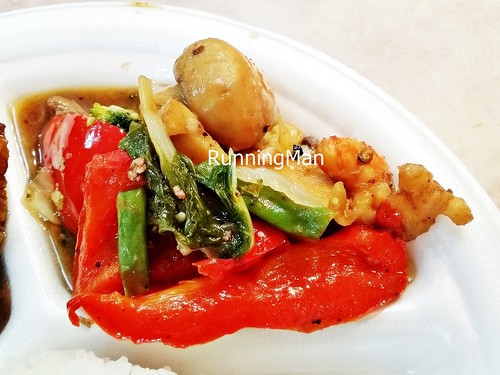 |
| Chop Suey Guisado |
Sinigang Pork (SGD $2) is a popular Filipino stew that derives its signature sour flavour from tamarind. Whilst commonly eaten by locals of the Philippines, it's an acquired taste for Singaporeans, being more sour than anything in Singaporean cuisine. I quite like it though! The pork ribs within the soup are soft and tender, with the meat coming off the bone easily. The vegetables, which include tomato, onions, eggplant, string beans, and white daikon radish, are fresh, and super soft. Best eaten with plain white rice!
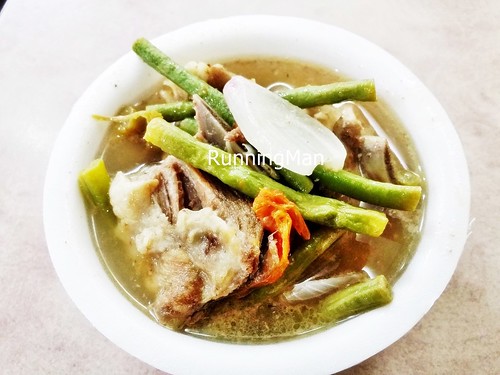 |
| Sinigang Pork |
The people of the Philippines love their pork, with a large majority of their food revolving around it! A hot item with the Filipinos here is the Lechon Kawali Roast Pork Belly (SGD $4), it features a crisp crackling / skin, that shatters when bit. However, I find the meat to be very dry. In a Singaporean context, this dish is average at best, you can easily get better Chinese roast pork from a Cantonese roast meat stall. I've tasted better renditions in Manila too. Probably the weakest dish available here, skip this!
 |
| Lechon Kawali Roast Pork Belly |
Kalamay Malagkit Ube (SGD $2) is a popular dessert in the Philippines. 'Kalamay Malagkit' refers to a glutinous rice pudding cooked in a banana leaf with sugar and coconut milk, while 'Ube' refers to a purple yam / taro. The yam / taro is grated, and combined with the sweet sticky rice to form a soft, but firm textured cake / pudding. Vanilla is sometimes added to the sticky rice for flavour, and the final dessert is usually garnished with fried coconut flakes.
 |
| Kalamay Malagkit Ube 01 |
 |
| Kalamay Malagkit Ube 02 |
Another one-dish meal usually consumed for breakfast in the Philippines, Tosilog (SGD $6.50) is the Philippines portmanteau of Tocino, Sinangag, and Itlog (Fried Sunny Side Up Egg), served with a side of Atchara (Pickled Payapa Salad), and fresh cucumbers and tomato slices. This dish is a sinful, guilty delight, being rather oily, but also very flavourful.
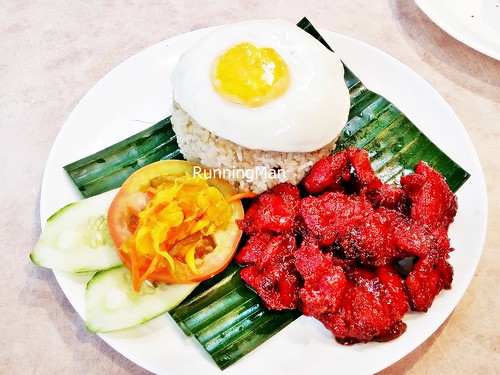 |
| Tosilog 01 |
 |
| Tosilog 02 |
Tocino refers to Filipino style bacon, made by curing pork loin meat or pork belly in a mixture of water, salt, sugar, annatto seeds, and aniseed. This results in Tocino Pork (SGD $3) having a slightly sweet and tart flavour, alongside its savoury taste and firm texture. Less salty than regular bacon, it's almost similar to Chinese style Bak Kwa, only with a sweet taste at the front, and a thicker, meaty texture.
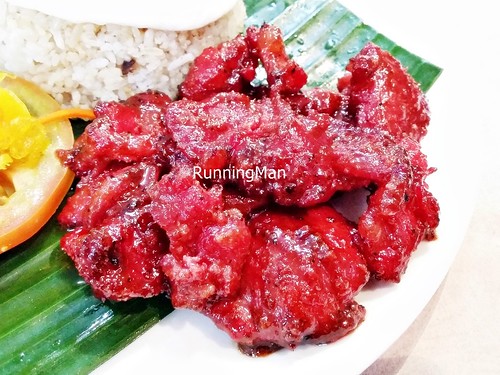 |
| Tocino Pork |
Atchara Pickled Papaya Salad (SGD $0.50) is usually served as an appetizer or as a side dish to a meal. Made with unripe green papaya, bell peppers / capsicum, onions, carrots and garlic, the mixture of vegetables is then pickled in a solution of vinegar, sugar, and salt. Although every region in the Philippines has its own version, the flavour of this salad is generally tart, sour, and refreshing. Best served when accompanying fried or oily foods, the salad lends a burst of crunchy freshness, and relives the heaviness of the oil.
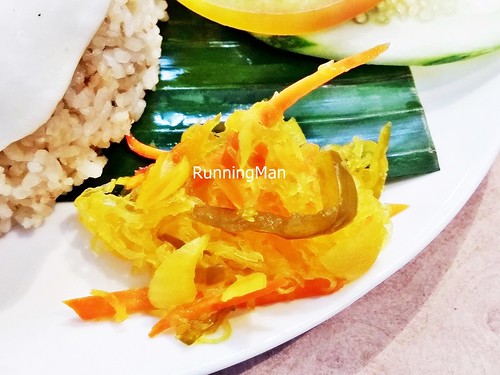 |
| Atchara Pickled Papaya Salad |
Silog is the Philippines portmanteau of Sinangag and Itlog (Fried Sunny Side Up Egg), and can be added on to almost any main dish (meat or seafood), to create a one-dish meal.
 |
| Silog |
.....


CONVERSATION